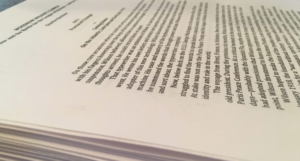
Whether you write a short or long document, you need to get all the following points right—usually in this order:
- Focusing. Ideally, every document states and delivers on The One Idea. Readers can understand a variety of concepts and facts, but they need to hang it all on a central, driving idea. Working together, we will figure out the driving idea of your documents. The could happen right away or it might take awhile. It depends. But when you get this right, everything else flows beautifully.
- Blocking. When we write, we relate a whole bunch of ideas, facts, illustrations, metaphors, and more. Often, we mix up our ideas. We define some ideas inadequately or do not provide the best evidence. Sometimes we blur or repeat ideas. Sometimes we fail to provide illustrations or evidence. So we lose ourselves—and our readers. We can attack this problem by blocking the main ideas and organizing them in a logical and even dramatic sequence.
- Storifying. The best writing operates on a narrative level. Even when exploring the most abstract concepts, we can use a narrative undergirding to make ideas more logical and give them greater spark. Most readers won’t recognize your narrative technique. But they will follow what you say—with interest—when you use it.
- Wordsmithing. Mark Twain once said that “the difference between the right word and almost the right word is the difference between lightening and a lightening bug.” The best writing finds the exact right terms to explain and illustrate ideas. It also uses a clear, energetic style to engage the reader.
- Detailing. Writers lose credibility when they make unnecessary mistakes—spelling, repetition, inexact terms, clunky phrases, and more. So before we close a project, we must line-edit our writing carefully. That usually requires more than one set of eyes.
This is what we do, document after document.
